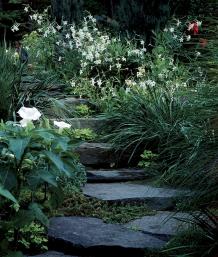
I quit smoking years ago, but I still don’t plan to give up tobacco. Not flowering tobacco, anyway. This hardworking genus (Nicotiana spp. and cvs.) adds so much to my garden that I can’t imagine being without it. I’m not talking about the cute little hybrids offered at garden centers. The breeder’s art may have created a richer color palette and compact plants with more profuse flowers, but only at the expense of the stature, sheer exuberance, and intense fragrance that makes the parent species so endearing. The kids are OK, but it’s their parents—the unadulterated, straight-species nicotianas—that bring wow-power to any garden scene. Yet somehow the best of the flowering tobacco bunch are unknown to many gardeners. Most don’t even rate a common name. They’re usually just called nicotianas.
Most species of nicotianas are short-lived, tender perennials easily grown as hardy annuals. They add bold architectural presence and complement virtually any setting. They excel at bridging gaps between young perennials and shrubs and filling holes left by spring-blooming, summer-dormant plants such as spring bulbs or oriental poppies (Papaver orientale). Depending on the species, you can get sweet-smelling fragrance, colorful flowers, or fleshy blue-green foliage. My favorites are also sizable; I don’t bother with any that won’t get at least 3 feet tall. Most are tough enough to march right through light frosts, so they help carry the garden’s banner of beauty into late fall. They thrive in full sun or part shade and are so easy to introduce that all you need do is scatter seed in early spring.
Nicotiana at a glance
Nicotiana spp. and cvs.
Nik-o-shee-ANN-ah
- Most nicotianas are tender perennials hardy only to Zones 9 or 10. So treat them as annuals in cooler climates.
- Nicotianas grow best in full sun but are adaptable to shade.
- They can thrive in almost any type of soil, but perform best in rich, moist soil that drains well.
- Do not plant near other members of the nightshade family (Solanaceae), since they can transmit the tobacco mosaic virus. Aphids and slugs are sometimes attracted to them.
- Propagate plants from seed or from root cuttings. Hybrid seedlings are often variable. Several species self-sow.
Fragrant nicotianas smell sweetest after dusk
Nicotianas are often noted for their scent, and several of the clan smell sweet indeed. My favorite for fragrance is jasmine tobacco (Nicotiana alata). It’s hard to imagine a more intoxicating scent. Many summer night, my wife and I sit outdoors bewitched by the blossoms’ fragrance and enchanted by the play of moonlight silvering jasmine tobacco’s snowstorm of white flowers. Since this plant so enhances evenings in the garden, I grow them wherever we spend time outdoors after sunset. Bright and fragrant by night, these flowers seem overcome by their efforts during the day, when they droop and wither under the sun’s onslaught. Like many of its kin, jasmine tobacco likes it cool. Where summers are hot, it fares better in part shade.
With white flowers and coarse, large foliage, jasmine tobacco is at home almost anywhere there’s space. I like growing it in drifts of a dozen or more with about a foot between each plant. More plants means more fragrance, and the crowding accommodates jasmine tobacco’s somewhat floppy habit by allowing each plant to lean against its neighbors. That floppiness prompts me to stake at least a few plants each season, a task best done early on so that flowering stems grow upright. Those pencil-thick stems can rise to 4 feet and are capped with a chorus of trumpet-shaped flowers, each flaring to a starlike tip.
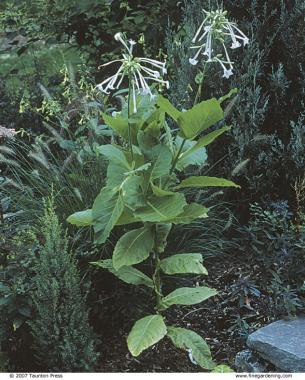
I prefer to grow the straight species, but several seed strains— whose names suggest their attributes—are available, including ‘Grandiflora’, ‘Fragrant Cloud’, and the small ‘Dwarf White Bedder’, which tops off at only 18 or so inches. N. alata is one parent for many, if not most, of the hybrids available today.
Perhaps better known is woodland tobacco (N. sylvestris). Intensely fragrant by night, but not as sweet as jasmine tobacco, it boasts several other virtues as well. I’m always on the lookout for big-leaved plants that take full sun, and this nicotiana provides an almost tropical touch with its dark-green leaves growing up to 2 feet long and a foot across. This hefty plant reaches up to 6 feet high and is crowned by clusters of pendant, white flowers that look like a burst of fireworks. Blossoms are 4- or 5-inch-long tubes tipped with a flared star.
Though most references say this nicotiana rarely needs staking, I’ve not found that to be the case, especially in windy sites. There’s no debating this though: These plants are dramatic enough to plant anywhere as lone specimens, perhaps accounting for the name of a popular woodland tobacco seed strain: ‘Only the Lonely’. They’re great at filling holes in the garden picture, creating appealing backdrops, or as repeating elements at midborder. Used freely, they add an air of maturity to a new garden.
Diplomatic flowers resolve border disputes

Fragrance is fine, but another Nicotiana species plays a more useful role in the colorist’s garden. N. langsdorffii, with broad deep-green leaves nearly a foot long and panicles of flowers the color of a Granny Smith apple, represents the height of garden diplomacy. It mingles well with almost any other plant and looks especially handsome with dark-foliaged trees or shrubs like purple smoke bush (Cotinus coggygria ‘Royal Purple’) or ‘Diabolo’ ninebark (Physocarpus opulifolius ‘Diabolo’). N. langsdorffii is also good with grasses. I like it with Japanese forest grass (Hakonechloa macra ‘Aureola’) or Bowles golden sedge (Carex elata ‘Aurea’).
Companionable as it is, N. langsdorffii comes into its own as a moderator wherever colors clash. A single plant placed between the opposing forces of, say, a warm pink and a cool red, serves as a bridge between the disparate hues. That chameleonlike quality makes this nicotiana’s propensity to self-sow most welcome; no matter where its progeny appear, they look great.
These plants are reputedly able to reach heights of 5 feet, but they usually top off in my garden at about 3-1/2 feet. This plant looks best in clumps of three or as solitary specimens peppered about for continuity. Though their stature seems to call for a spot near the back of the border, I think they’re more effective at midrank, to better emphasize their stately presence and the green floral bells, each enclosing a cluster of beautifully blue anthers.
Use root cuttings to grow your best nicotianas again and again
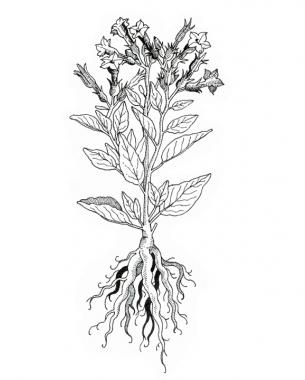
Every now and then a superb form of Nicotiana grows from a slew of seedlings. It might have a spectacularly saturated color, an unusual hue, or a uniquely large or double flower. When that happens, I take root cuttings in fall.
After a few light frosts, most nicotianas are still vital, but slowing. That’s the time to dig a selected plant carefully and examine its fleshy roots. Once the roots are out of the ground, I keep them moist and cool. As soon as possible, I make cuttings of the thickest root strands using a sharp knife or razor. I look for strands about the diameter of a pencil and sever them near the plant’s crown.
Since new plants will grow only from the top of the root—the end that was nearest the plant’s crown—polarity is important. You have to remember which end of the root was nearest the plant or you may plant it upside down. The time-honored way of marking root cuttings is to make the cuts straight across the end of the root nearest the plant, and to make cuts at the other end of the root at a 45-degree angle, leaving about 3 inches between the cuts. When it comes time to plant, in early spring, put the cutting in the soil medium with the pointed end down.
Once I make cuttings, I never let them dry out. They go into a plastic bag with moist sand or peat to overwinter in a cool spot in my basement. About the time I sow nicotiana seeds, I plant the root cuttings, with the tops just buried in sterile, soilless medium. I keep the pots warm and the medium moist. When little plants appear, I repot and grow them on like any other nicotiana seedlings.
Tobaccos for colorful foliage or flower
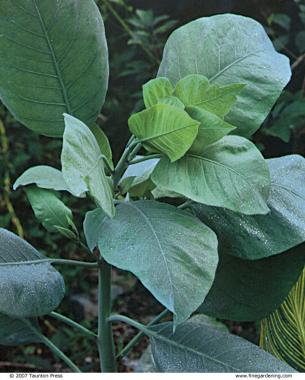
Happily, this plant genus prized for fragrance and flowers includes a foliage plant of the first rank. Tree tobacco (N. glauca) bears fleshy, almost succulent, saucer-sized leaves colored a lovely silvery blue. This tender perennial can be easily grown from seed as an annual and, in a single season, makes the incredible leap from a dust mote of seed to a skyscraping specimen 10 or more feet tall. Plants are a little rangy, but plenty of pinching helps keep tree tobacco at a size suited to a more modest perennial border. The plant bears yellow flowers, too, though in my USDA Hardiness Zone 6 garden I’ve yet to see one.

Color is not really the strong suit of Nicotiana species, but there are a few worth growing that fit into almost any planting scheme. The true tobacco plant (N. tabacum) is 5 feet tall and crowned with slightly upraised, plump, little pink flowers. For yellowy-chartreuse flowers, I like a passalong seed strain known as ‘Nancy Ondra’s Green Mix’, said to be the offspring of N. langsdorffii and an N. alata seed strain called ‘Lime Green’. Mine usually reach about 3 feet tall with star-tipped, trumpetlike flowers an inch across.
Members of the nightshade family, nicotianas’ relatives include tomatoes, peppers, and eggplants. Nicotianas should never be grown near these vegetable-garden stalwarts, since the easily transmitted tobacco mosaic virus could wipe out any hope of a crop. Since the virus can also be carried in tobacco products, smokers could unwittingly infect garden plants. Aside from that, nicotianas are forgiving. Though best grown in full sun in richly organic, moist but well-drained soil, they’re not fussy. They’ll take almost any soil and thrive with as little as a couple of hours of direct sun a day.
Start seeds inside
To get nicotianas going, you could just scatter seed in early spring, but you won’t get much of a display until August. For earlier blooms, I start the minuscule seeds inside 8 to 10 weeks before the last frost date. Seeds should be surface sown, since they need light to germinate. In 10 days or so, the seeds sprout and soon form attractive little rosettes. Leaves yellow quickly if the seedlings get hungry. I feed them with a weekly draught of fish emulsion and water-soluble 20-20-20 fertilizer, using each at half strength. As the frost-free date nears, I gradually acclimate seedlings to life outdoors. By early summer, nicotianas started indoors should be in bloom. Once up and running, plants are essentially problem-free, though aphids sometimes favor woodland tobacco, and many species are prone to slug attacks in moist, shady sites. Nicotianas flower like fiends, so deadheading to prolong bloom seems superfluous. Instead, I give plants a quick clean-up by clipping whole wands of flowers just as they start to decline. I clip stems just above a lower leaf, which encourages a new flowering stem to burst forth, especially when pushed along by a soaking with a water-soluble 20-20-20 fertilizer.
Once established, most nicotianas self-sow. They’re not invasive, but seedlings sprout so thickly they need rigorous thinning, once at tulip time and again in early June. I thin them to about a foot apart and use discards to extend a drift of plants or to introduce them to a new area. With this kind of tobacco, you can’t overdo it.

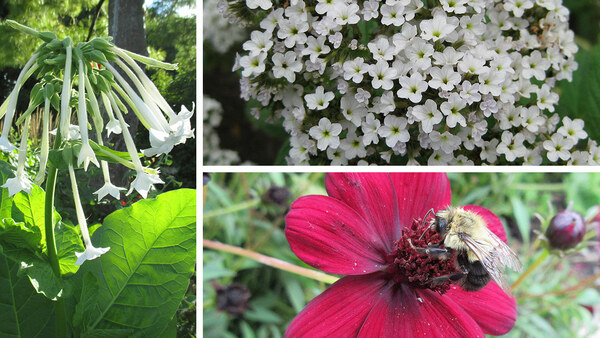

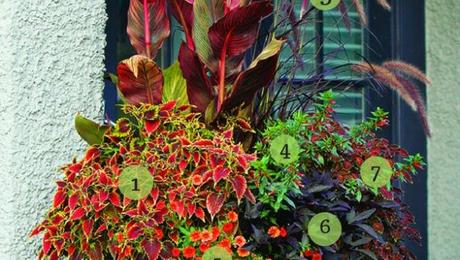













Comments
Can the dried leaves or flowers be used for smoking?
Log in or create an account to post a comment.
Sign up Log in